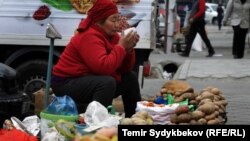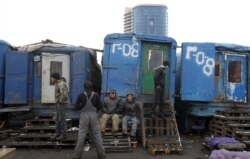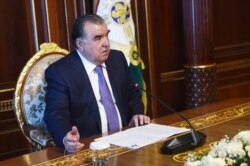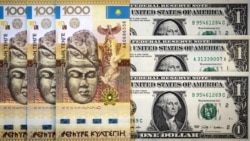It’s looking like deja vu of the worst kind in Central Asia as a new economic jolt is coming to the region, only this time with some added bad news.
The jolt means that the price of oil has dropped dramatically on world markets -- much as it did in 2014.
For the five Central Asian countries -- whether dependent on hydrocarbon exports for revenue or remittances from millions of migrant laborers in Russia -- the decrease in oil prices six years ago heralded significant downturns in their economies.
Turkmenistan, for example, has still not recovered economically from the drop in the price for natural gas that accompanied the fall in oil prices, though much of the blame for Turkmenistan’s failure to bounce back lies in the government’s lack of diplomatic or foreign-trade skills.
Some of the Central Asian governments are already moving to head off the problems they faced in 2014, and there are some reasons to think the difficulties that beset the region then will not be as severe this time.
But the added bad news -- the spread of the coronavirus and the accompanying global deceleration of production and trade -- is something that didn’t exist in 2014 and will certainly add to the woes that await Central Asia.
Sending Money Home
Tajikistan and Kyrgyzstan are two of the most remittance-dependent countries in the world (currently occupying the fourth and fifth spots, respectively) and the vast majority of migrant laborers from these two countries work in Russia.
Among Central Asian migrant workers, Uzbeks actually send back the most money from Russia. Uzbekistan’s percentage of gross domestic product (GDP) in 2013 from remittances was only 9.69 percent, though it fell to 3.74 percent in 2015, according to the World Bank.
Interestingly, since President Shavkat Mirziyoev came to power in late 2016 -- and Russian-Uzbeks relations significantly improved -- remittances bumped up to account for some 12 percent of Uzbekistan’s GDP in 2017 and 15 percent in 2018.
According to World Bank data, remittances accounted for almost 44 percent of Tajikistan’s GDP in 2013, just over 37 percent in 2014, down to under 29 percent in 2015, and to a bit under 27 percent in 2016. The share of GDP went up to 31 percent in 2017 and was 29 percent in 2018.
Remittances accounted for some 30 percent of Kyrgyzstan’s GDP in 2014 and fell to about 25 percent in 2015. It increased to some 29 percent in 2016 and 33 percent by 2018.
In early 2016, Tajikistan’s National Bank said Tajik migrant laborers in Russia actually sent back more rubles in 2015 than in 2014, but the depreciation of the ruble meant the money sent back to Tajikistan was worth 33 percent less in 2015.
In 2014-15, the Russian ruble fell from 32.85 to $1 to 72.69/$1.
The Russian ruble rate was about 66/$1 on March 3, 2020, and one week later it fell to 71/$1 (down from a high of 74/$1 on March 9).
What’s Different This Time?
The health of the Russian economy is of course of vital importance to the Central Asian economies.
And with the economic problems for Moscow just starting, Russia’s Finance Ministry said on March 9 that the country had sufficient resources to keep afloat for six to 10 years if the price of oil was $25-$30 per barrel.
But the Finance Ministry may have just been putting on a brave face and the situation could deteriorate much further.
With President Vladimir Putin having just moved to possibly secure his spot as Russian leader for many years to come but with polls showing declining public support for him, the Kremlin will be anxious to avoid a plummet in the ruble’s value.
That should at least delay the sort of impact on remittances from Central Asian migrant laborers that was seen in 2015 and 2016.
If Not Russia, Where?
If the ruble does take another dive, that creates another problem for Central Asia.
The number of migrant laborers going from Kyrgyzstan to Russia actually increased in 2015 by 2 percent, owing, no doubt, to Kyrgyzstan’s entry into the Russian-led Eurasian Economic Union that year, which afforded better working opportunities in Russia for citizens of member states.
But Russia’s Federal Migration Service reported that the number of migrant laborers from Tajikistan decreased by 3.8 percent (some 35,000) and the number from Uzbekistan by 4.1 percent (some 80,000 people) in 2015.
Some may have returned home, and Tajik President Emomali Rahmon recently claimed the number of Tajik migrant laborers had decreased to some 486,000.
But there were other options for Central Asian migrant workers five or six years ago when they could choose to go to countries in the Middle East, Turkey, Japan, or South Korea.
But with the spread of the coronavirus, many countries are closing off access and those arriving face enhanced scrutiny. The opportunity to travel to any of the above places to seek a job will be reduced.
That could lead to more people returning home, but employment will be difficult to find in Kyrgyzstan, Tajikistan, and Uzbekistan, and the addition of thousands of working-age citizens to the ranks of the unemployed in those countries would put additional strains on the public dissatisfaction that exists in those societies.
The Value Of Money
Kyrgyzstan’s national currency, the som, started 2015 at a rate of 58.89 soms to $1 and started 2016 at a rate of 75.89 soms/$1.
Kyrgyzstan’s National Bank made 16 currency interventions in 2015, spending some $37 million to prop up the som, and staged 12 such interventions in January 2016 alone, spending nearly $54 million.
The exchange rate on March 3, 2020 was about 69.8 soms/$1 and on March 10 the rate jumped to 74/$1.
The head of Kyrgyzstan’s National Bank, Tolkun Abdygulov, said on March 11 there would be no large problems in the current situation, but added that the bank had intervened to support the currency the previous day, “since there was a great demand [for hard currency] and panic broke out.”
Tajikistan’s national currency, the somoni, started 2015 at a rate of 5.3 somonis/$1 and began 2016 with a rate of 7.1/$1.
Tajikistan’s National Bank spent some $452 million in 2015 defending the somoni.
The exchange rate for the somoni was 9.68/$1 on March 3, 2020, and was roughly the same on March 10.
What’s different now as opposed to 2014 is that the impact of a possible economic downturn in Russia might not be as hard as it was six years ago.
The Central Asian governments gained experience from the previous drop in oil prices and announcements from central banks in Kazakhstan and Kyrgyzstan indicate that the governments in those countries are reacting early to head off currency problems.
But Kyrgyzstan and Tajikistan, in particular, have limited reserves and cannot continually move to prop up national currencies.
The Oil And Gas Barons
Naturally, the two Central Asian countries that depend on oil and gas exports for revenue -- Kazakhstan and Turkmenistan -- are the first to be hit by the drop in the price of oil.
Kazakhstan was by far the hardest hit country in Central Asia the last time difficult economic times came, but that was partly due to the decision on August 20, 2015, to allow the national currency, the tenge, to float.
That day, the rate fell from 188 tenge/$1 to 255 tenge/$1 and, by the start of 2016, it had dropped to 340 tenge/$1.
The Kazakh government revised the budget three times in 2015 as oil prices continued to drop.
Many people in Kazakhstan who took out hard-currency loans for automobiles, homes, or other large purchases in the heady decade that preceded the tenge’s devaluation were almost wiped out.
In hindsight, one can see this sudden downturn in the economy sparked the social unrest that has evolved into recent rallies and demonstrations in Kazakhstan for an increasing variety of reasons.
The Kazakh government was quick to act this time to prop up the tenge, announcing on March 9 that it was planning currency interventions “to ensure stabilization of the foreign exchange market and financial stability.” And on March 10, Central Bank chief Yerbolat Dosaev announced the bank was hiking its policy rate from 9.25 percent to 12 percent to alleviate pressure on the tenge.
All the same, the tenge fell from about 380/$1 on March 3 to nearly 400/$1 on March 10.
Kazakh Energy Minister Nurlan Nogaev said on March 7 that his country would take steps to cut costs.
“We have budgeted the oil price at $50-$55 [per barrel]. If it falls to $40 and below, the government has a plan to optimize the costs and we are already working on it,” he said.
The price of Brent crude, the international benchmark, was already under $40 per barrel as of March 11 and it’s expected to go lower.
Kazakhstan has signaled that it would not ramp up production to compensate for the falling price of oil, but that decision might change.
Turkmenistan is so mismanaged that it is unlikely the government can or would take any exceptional measures to head off the coming crisis.
'European Prices'
A decade ago, Turkmenistan was counting on selling its gas for “European prices” that were at that time well over $300 per 1,000 cubic meters.
A report in December 2019 said the price for Russian gas to Europe in the third quarter of that year had fallen to $169.8 per 1,000 cubic meters.
That was for Russian gas shipments to Europe. Turkmen gas has no chance of selling gas at that price.
The difference this time is that Russia unilaterally canceled its contract to buy Turkmen gas at the start of 2016. By then, Russian imports of Turkmen gas had fallen from some 40 billion cubic meters (bcm) in 2008 to 4 bcm in 2015.
Finally, in 2019, by which time Turkmenistan was deep into an economic crisis, Russia agreed to resume purchases of a relatively modest amount of Turkmen gas -- some 5.5 bcm -- at a reported price of “no more than $110 per 1,000 cubic meters.”
As the price of gas follows falling oil prices in the weeks and months to come, $110 per 1,000 cubic meters might seem generous before the end of this year.
Turkmenistan cut off gas supplies to Iran at the start of 2017 citing what Ashgabat said was an unpaid Iranian debt of somewhere around $2 billion from supplies received nearly a decade earlier. Iran contests the amount and the quality of the gas received. There has been no significant movement towards resuming Turkmen gas supplies to Iran even though Turkmenistan could desperately use that or any other source of income.
That leaves Turkmenistan with only China as a major gas customer, and as has been pointed out before, Ashgabat owes China billions of dollars for loans to develop Turkmen gas fields and build the pipelines that carry Turkmen gas to China. An unknown percentage of Turkmenistan’s gas shipments to China goes toward paying off those Chinese loans.
On March 5, Reuters reported that, due to the coronavirus outbreak in China, the country’s leading gas importer, PetroChina, was declaring force majeure on gas imports.
Reuters quoted a “source with direct knowledge of the situation” as saying “The supply cuts will fall on suppliers proportionately but LNG [liquefied natural gas] suppliers will have a lesser impact versus those on piped gas.”
The actual proportion itself was not specified but on March 11, Kazakh Energy Minister Nogaev said, “at China’s request,” Kazakhstan would be reducing the amount of gas it pumped into the three operating pipelines running through its territory from Turkmenistan to China by 20-25 percent. Twenty-to-25 percent would then seem to be the proportional cut all those who sell gas to China via pipelines face.
The three pipelines from Turkmenistan to China -- A, B, and C -- will have a capacity of some 55 bcm annually when they reach full capacity, which they are close to achieving already. Since the three pipelines also run through Uzbekistan and Kazakhstan, those two countries can ship up to 10 bcm of their gas to China, though neither has so far put that much into the pipelines.
Turkmenistan now faces not only even lower prices for its gas but is also looking at temporarily losing up to one-quarter of the income it does receive from China. To put that in perspective, Turkmenistan is exporting probably close to the 35 bcm allotted for its gas in the three pipelines, but that will now be reduced by somewhere between 7 to 8 bcm, more than the amount of gas Turkmenistan just started selling to Russia.
The Kazakh government will hopefully have learned from the experience of five and six years ago, but there is a new president there, at least in name.
Qasym-Zhomart Toqaev stepped into the president’s office in March 2019 when Kazakhstan’s first and only president, Nursultan Nazarbaev, announced he was stepping down. It is clear Nazarbaev is still in charge in Kazakhstan, but the change in presidents invigorated those in the country who are waiting for change.
There have been more public demonstrations for more reasons in Kazakhstan in the last year than there probably were combined in the 10 years prior to 2019.
Demands for better social benefits have been at the center of protests, often by working mothers with large families. The government has promised to increase benefits and has implemented some changes, but if the economy takes another downturn it will be difficult to fulfill all the pledges it has made.
Nazarbaev made it through the previous period of economic decline partly because he was the only president the country had ever known, and Kazakhstan was coming off an extended period of economic growth. Another economic downturn coming so shortly after recent hard times will put immense pressure on Toqaev’s government.
It is worth noting that Uzbekistan also has a different leader than it did in 2014, but Uzbekistan actually has reason to hope Shavkat Mirziyoev will be more effective in dealing with an oncoming economic crisis than his predecessor was.
First President Islam Karimov’s response to the economic problems five or six years ago was to do almost nothing. Uzbekistan is already self-sufficient for many of its needs and as the country’s economy took a beating, Karimov made no significant moves to alleviate the situation.
Mirziyoev, if nothing else, has shown more energy in office and a willingness to try new ways to bring Uzbekistan out of the economic malaise Karimov left behind.
And one new factor that will hit all the Central Asian countries is the general slowdown of China’s economy due to the outbreak of the coronavirus and the accompanying reductions in production.
The cuts in gas are one example, but five or six years ago China still had lots of money to spend and did so, continuing to invest in projects in Central Asia and -- some would add -- increasing the debts of these countries to China. The Central Asian states will not be able to depend on receiving as much Chinese money this time.
No one in Central Asia wants the economic problems that appear to be coming. They might be better prepared to deal with some aspects of these problems, but surely many are like Kazakh Energy Minister Nogaev, who mentioned when announcing the gas reduction to China that there is hope for another meeting of OPEC and non-OPEC oil-exporting countries soon that could patch up the damage left behind when their March 6 meeting broke up amid deep disagreements.














